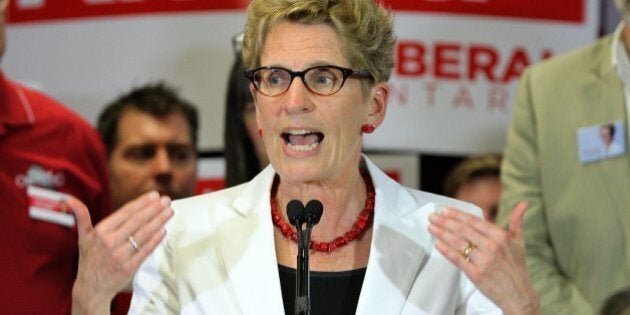
Polling in the Ontario election has been a little less than clear. Some polls show a comfortable lead for Tim Hudak's Progressive Conservatives. Others show an advantage for Kathleen Wynne's Liberals.
A new poll is in the latter category.
The poll, conducted by EKOS Research for iPolitics via interactive voice response and surveying 1,111 Ontarians between May 13 and 15, gave Wynne's Liberals 37 per cent support, against 30 per cent for Hudak's Tories. The New Democrats, under Andrea Horwath, stood at just 21 per cent support, while the Greens were at seven per cent.
The changes since EKOS's last poll (conducted April 25 to May 1) were all within the margin of error, suggesting that the race remains a relatively stable one. Some other polls, while disagreeing on who holds the lead, have suggested something similar.
The longer term trends, however, hint that the Liberals may be making gains. This is the second consecutive EKOS poll in which the Liberals have increased their support at the expense of the NDP. In a poll conducted by EKOS at the end of March and beginning of April, the Liberals had just 32 per cent support, against 29 per cent for the NDP.
But Hudak may have an ace up his sleeve. Polling by Ipsos Reid has shown the Tories have a distinct advantage among likely voters, and in particular older Ontarians. EKOS shows the same thing. Despite the overall Liberal lead province wide, the PCs had 42 per cent support among voters aged 65 or older, against just 34 per cent for the Liberals.
In other words, the PCs could still outperform the polls that have them trailing if more of their supporters make it to the polling stations than those of their rivals.
Turnout could be a big problem on election day. An anomaly of the poll was the high number of respondents who said they would vote for another party: 4.5 per cent. Frank Graves of EKOS explained in his poll report that this was likely not a real indication that fringe parties were about to make a breakthrough, but rather this was the choice of voters who wanted to express a ‘none of the above’ perspective. These voters may stay home on June 12.
A large proportion of Ontarians (19 per cent) also said they were undecided, so there is still much scope for change in the next three-and-a-half weeks.
Regionally, the Liberals put up their highest numbers in Toronto, where they led with 52 per cent support. The PCs, at 26 per cent, and the NDP, at just 14 per cent, followed. The Liberals were also ahead in northern Ontario, with 39 per cent to 20 per cent for the Tories.
The PCs were in front in the 905 area code with 35 per cent, trailed closely by the Liberals at 33 per cent. The Tories also held narrow leads in southwestern Ontario (31 per cent to 30 per cent for the Liberals) and eastern Ontario (35 per cent to 34 per cent for the Liberals).
The NDP's best score was in the southwest, where the party had 26 per cent. New Democrats are banking on a breakthrough into southwestern Ontario, following up on their series of byelection victories.
With the contradictory polls being published at this stage of the race, it is difficult to know who is truly ahead. What does seem to be the case, however, is that no party has been able to impose itself on the campaign so far, or make a dramatic move in one way or another.
For the incumbent Liberals, that may be just what they need in these early days.
Éric Grenier taps The Pulse of federal and regional politics for Huffington Post Canada readers every week. Grenier is the author of ThreeHundredEight.com, covering Canadian politics, polls and electoral projections.
Also on HuffPost
